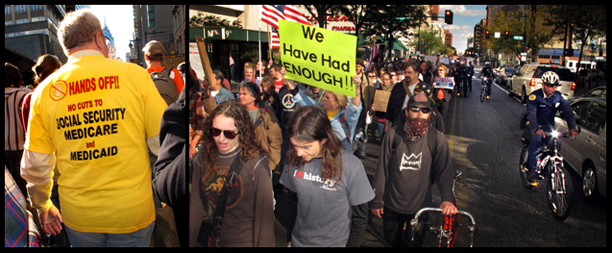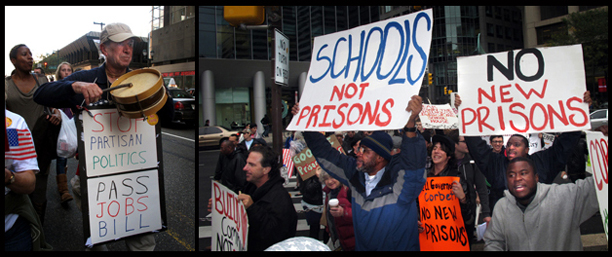Philadelphia — Common Terry was in a buoyant mood as he marched along Market Street Saturday afternoon along with a couple hundred activists who, following a rally outside the Liberty Bell pavilion, headed over to Philadelphia’s ornate City Hall to join the thousand or so occupiers camped out there.
“We’ve been occupying places for a long time,” said the laid off part-time teacher from Oakland, California. “University administration buildings, parks in Berkeley, nuclear plants. And now we’re occupying the centers of cities!”
Terry, who says he has been shuttling back and forth between the occupations in Philadelphia and New York, said he had purchased a one-month $60 Trailpass on Greyhound and was planning to attend a number of other occupation sites around the country.
The movement is clearly growing in size, and impact.
 Gathering at Independence Mall before march to Occupy Philadelphia at City Hall (Photos: John Grant)
Gathering at Independence Mall before march to Occupy Philadelphia at City Hall (Photos: John Grant)
“This is cool. It’s a good thing they’re doing. Living democracy in action,” said two tourists outside the Constitution Center, as demonstrators marched past carrying signs saying “Hands of my Security and Medicare!” and “Tax the Rich!” and chanting “Banks got bailouts! We got sold out!”
A second couple, Christie and Billy Leetch, down from Boston, said they were happy to see the occupation happening in Philadelphia. “The one in Boston was violently attacked by the police a few days ago,” said Christie. “It was really disgusting, watching them arresting peacefully demonstrating veterans.”
“I agree with the message, and with the civil unrest,” said her husband. “It’s the only way to effect change without picking up guns.”
 Marchers head across Market Street toward City Hall accompanied by PPD Strike Force
Marchers head across Market Street toward City Hall accompanied by PPD Strike Force
While the demonstration at Independence Mall was underway, a phalanx of Philadelphia Police, mounted on bikes and wearing jackets that said “Police Strike Force,” waited in a line along the 6th Street Boundary, looking ready to roll out and bang heads. It was a strikingly aggressive image juxtaposed to the completely peaceful crowd assembled across the street from them, and seemed wholly inappropriate. The crowd ignored the biker cops.
 Marchers approach City Hall location of Occupy Philadelphia
Marchers approach City Hall location of Occupy Philadelphia
Once at City Hall, it became immediately apparent why the city was complaining about having to spend an alleged $400,000 to “accommodate” the protesters encamped outside the ornate building. At every entrance to the block-sized edifice, there were 6-10 cops lounging around earning overtime and looking totally bored. City Hall, a towering stone structure that rises castle-like around a huge open square, was completely fenced off around its circumference by bicycle-stand-like metal barricades, behind which numerous armed cops stood.
Clearly a lot of public employee time had gone into shipping in and setting up those barricades, and even more was going into paying for the round-the-clock police guard.
None of it is needed. On the west side of the building, where there is a large plaza, several hundred brightly-colored, igloo-shaped tents have been pitched by the occupiers, who number perhaps 800 or so. The mood is festive and calm. Two cops standing at either end of the plaza would suffice to provide security, or call for back-up if anything untoward were to happen. No clean-up crews are required. These occupiers, like their compatriots in the Occupy Wall Street action, are keeping their grounds cleaner than they’ve ever been kept by city workers.
 Philadelphia City Hall, site of Occupy Philadelphia
Philadelphia City Hall, site of Occupy Philadelphia
The complaint about public costs of the occupations is as bogus as is the police ban in New York on umbrellas and tents.
Wilson Sproehnle, a 60-something Vietnam War era veteran wearing a Veterans for Peace T-shirt, and sporting long gray dreadlocks, is one of the occupiers at City Hall. He said, “This is just like the anti-war movement in the 1960s, and it’s also completely different.”
“What do you mean?” I asked him, a bit puzzled.
“Back in the ‘60s,” he explained, “you had a bunch of groups, each with their own agenda that they were pushing. And there were leaders back then, who would tell us what to do, and then we’d all do it. Now there are no groups with agendas. Just lots of people coming together to protest. And there are no leaders. Everybody meets together, everybody gets to say what they are thinking, and everybody discusses things until we reach agreement. It’s a beautiful thing!”
This was one occupation among hundreds across the U.S. and around the world on Global Occupation Day.
The encampment at City Hall here looks like it is settling in for the long hall. There is a registration tent, a medical tent, there’s even a beauty salon tent for those who want to attend to their appearance. Also, donations for supplies are pouring in and–no small matter — the owner of the privately-run underground mall area of the nearby Suburban Station of the city’s public transit system has told the protesters that they are welcome to use the public washrooms there 24 hours per day.
“The city has told us we’ll have to leave next month because they are supposedly planning to start work on putting an ice-skating rink here,” said one occupier. “But we won’t be iced out! They shouldn’t be spending public funds on a skating rink when schools and libraries are being shut down for lack of money. And besides, they are just putting a rink here because it’s the only spot around the City Hall building where there is room for people to protest.”
In fact, the plaza has been the scene of protests for decades. and would be hard to replace if it were removed.
Given the commitment of these demonstrators to stay put, it may not be something that Mayor Michael Nutter and the City Council will want to attempt.
